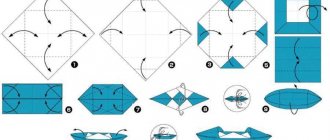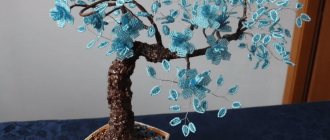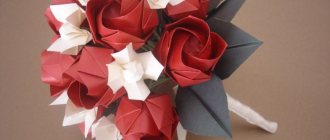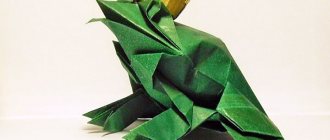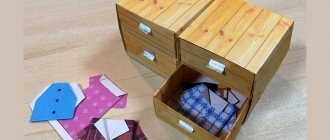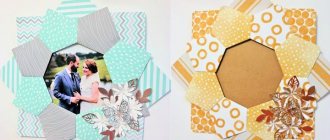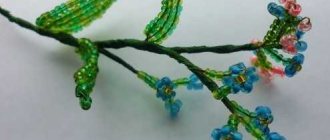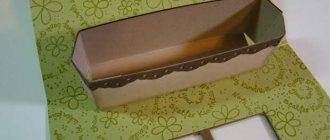Paper is one of the most difficult and capricious materials to work with. This is why masters love to work with it so much - the result is always worth the effort. Two sources of inspiration - material and nature - can be combined in one creation. An artificial water lily made from paper will delight any craftsman because he was able to repeat with his own hands an unsurpassed example of nature’s work in paper.
We study techniques for folding paper water lilies with our own hands
Modular origami.
Using different techniques, you can layer water lilies that are as beautiful as real ones.
The most common option, however, is not the simplest, making a flower using the origami technique.
To fold a water lily, as in the photo, you will need:
- 4 sheets of A4 paper (red or pink);
- 2 sheets of A4 paper (green);
- a piece of wire.
A sheet of paper of the main color (red or pink) is divided into 4 even parts, arranged along the width. To do this, you need to use a ruler and a simple pencil. The drawn lines are cut using scissors.
Now the strips of paper are folded in half in the longitudinal direction, that is, along the length. Then the corners and long sides of the strip are folded.
Now the resulting workpiece needs to be carefully folded in the middle in the other direction, outward, as if folded in half.
All 16 pieces of colored sheets, both red and green, must be prepared in this way for further work. Only one, the very last green piece, should not be turned outward, but rather inward.
Now the work with module failure begins.
To do this, two red ones are superimposed on the green blank.
You need to make exactly 8 such sets, using all the parts prepared earlier.
All modules fit tightly to each other.
The middle is fastened with wire, carefully wrapping the center several times, and securing the ends of the wire and carefully cutting them off. The blanks are straightened. To straighten it out evenly, you can use the wire as a support, pressing on it when bending the leaves and forming a circle.
Now you need to straighten the centers of the future petals. To do this, the inner layer of the sheet is bent inward. The depth and height of the bend can be adjusted at your discretion. The main thing is to do it carefully, so that if something needs to be corrected, you can do it without leaving creases on the paper.
The second layer of petals is folded in the same way. They should fit more or less tightly to the previous one. The bottom of the workpiece, where the green leaves will be, is straightened in exactly the same way.
If the leaves are not straightened evenly, making the bends larger or smaller, then the water lily will look even more like a real one.
Classic origami.
To make a snowflake using the classic technique, you need to bend a sheet of paper strictly along the lines shown in the diagram. The diagram is detailed and clearly shows the directions of the folds with arrows. However, it will be more convenient for novice masters to familiarize themselves with the description of addition.
- At the beginning of the work, an initial shape is made from a sheet of paper, which is called “Pancake”.
A square sheet of paper (this is important, the sides must be equal to each other, otherwise the flower will not be folded) is folded diagonally. The intersection lines of the diagonals are smoothed out well using a ruler or the back of the nail. Each corner of the vertex is folded in the direction of the center, with the vertex facing the other corners.
- After this, all corners of the workpiece are folded towards the central point.
- The same corners are bent again, and again to the middle.
- All lines must be marked. To do this, the sides of the triangle are bent in the opposite direction, towards the middle.
- All corners of the flower blank are bent like a mountain. Before this, folds are made along the lines so that the corners are turned out.
- The petals are also folded back into a “mountain”, thus marking folds. The workpiece turns over and the pockets of the petals seem to be flattened. To do this, you need to press them down well.
- The workpiece is turned over again. The inner corners are folded into a “valley”. To do this, they are turned outward.
- Similarly, it is necessary to open all the corners of the inner “pancake”.
- The workpiece is turned over again. If desired, you can pull out additional petal corners. This will give the water lily a more natural and open look.
The resulting flower can be used as table decor, to decorate a room with it, or as a craft for a child.
More ideas can be found in video lessons dedicated to the topic of the article.
Materials and tools for work
Classic origami was originally made from a square sheet of paper without the use of scissors.
Modern techniques allow the use of various types of materials and tools:
- Paper – you should choose enough paper
- New, matte, so that the folds bend easily and at the same time keep their shape.
- Glue will be needed for small parts and to secure the product if it is intended to be preserved as an exhibit.
- Paint – to give the desired color. It is more convenient to use spray paint.
- Scissors – it is advisable to have several sharp scissors of different sizes with ends of different shapes (straight, rounded). You can also use a cutter.
- For marking, you will need a simple pencil and simple drawing tools - a ruler for drawing a diagram, a triangle, a protractor for folding paper at a certain angle.
- Needle and thread - sometimes you need to sew them to secure parts.
- To decorate the product, you can use any available materials: buttons, beads, rhinestones, beads, scraps of fabric, etc.
Master class on making flowers
It is better for novice craftsmen to take on the simplest jobs. It must be borne in mind that, for example, manipulating crumpled paper requires some skill, while modular origami also requires precision, perseverance and takes a lot of time. You should thoroughly prepare for working on the chosen version of the water lily (water lily, lotus). Before starting, it is recommended to read the instructions, watch the corresponding video lesson, and print out the necessary diagrams and templates.
Paper water lily
Without much effort, you can make a rather impressive paper water lily with your own hands. Master class on its creation:
- Two circles of different diameters are cut out of a white sheet, for example, 10 and 7 cm.
- Each of them needs to be divided into 8 sectors. It is more convenient to do this if you first fold the circle in half, then bend it twice more through the center of the original circle. After this, the workpiece must be unfolded. You can also draw a circle by drawing 4 lines intersecting in its center.
- According to the folds or pencil markings, each of the circles is cut from the edge, slightly short of the middle.
- Opposite corners of one sector need to be brought together. Along the line of contact between the edges, the paper is fixed with glue. The result is a pointed petal. The rest of the petals are glued together in this way.
- Both pieces processed in this way are turned over, the smaller one is placed on top of the larger one and glued together in the center.
- A leaf is cut out from green cardboard according to the template. A water lily is glued onto it.
- From yellow paper you need to cut out a small circle 1-2 cm in diameter. It is smeared with glue and glued into the middle of the flower. The craft is ready.
Creating with children: making a “Water Lily” postcard
Handmade postcard with paper plastic elements
Materials: paper: white – 17*17cm, green – 15*30cm, yellow – 1.5*10cm, light green – 16*16cm, thick PVA glue.
Tools: a simple pencil, an eraser, scissors, a piece of linoleum, a toothpick, templates: a water lily leaf, circles with a marked center and division into 8 equal parts with a diameter of 8 and 6 cm, a poem about a water lily.
Card element - water lily flower: Place 2 circles with a diameter of 8 cm and 1 circle with a diameter of 6 cm on a white sheet of paper. Transfer the burrs and the center. Carefully cut out the circle with a pencil line leaving the outside of the circle. (we do not cut out burrs)
Using your thumb and index finger, mark the center of the circle, use scissors to press against the index finger and the burr on the edge of the circle, make a cut 1 cm short of the center. We will get water lily petals.
We wrap the water lily petal towards the burrs, carefully lubricate the edge with glue and fasten it according to the drawing.
We got three whisks for the water lily
Stamens: Take a yellow leaf. Create a fringe along the narrow side. We twist it into a sausage and secure it with glue.
The base of the card is a water lily leaf: Fold the green leaf in half. We trace the template of the water lily leaf according to the picture. When unfolding the postcard, it forms the letter “M”.
Assembling the postcard: It’s time to assemble all the details we created into a single original postcard. We take the base - a water lily leaf, flower corollas, stamens and glue them together according to the picture.
From the remnants of white paper, cut out three strips (sedge), which we curl using a pencil. We glue them together and glue them to one of the flower petals.
Congratulations! Your card is ready, now you can write in it everything you want to wish and give to your loved ones and friends. If you have time left. We take a light green leaf, put it in our card, cut out the silhouette of a water lily leaf 5 mm larger than the base. Glue it inside the postcard by 5mm. On this piece of paper you can write wishes or a poem about the water lily flower.
Quick diagram of a modular origami water lily
Cut the A4 sheet into 4 identical rectangles. You need 16 pink and 8 green such blanks.
Stages of work:
- Fold the rectangle in half. Expand.
- Fold the corners towards the center line.
- Fold to the center line of the side.
- Fold the workpiece in the opposite direction, with the folds facing outward.
- Make 16 of these elements.
- Green modules are made in the same way, only in the last step the fold is made inward.
- Make 8 elements.
- Take a green blank and place two pink ones on top of it.
- Make 8 such sets, fold them evenly together.
- Tie with wire in the middle.
- Straighten the pieces to make a circle.
- Fold the petals of the first layer up.
- Fold the petals of the second layer.
- Spread out the green leaves.
- The water lily is ready.
Video instruction:
Modular lotus
To make a flower you will need 16 sheets of 10x10 paper: 8 pink and 8 green. It is advisable to use rough material so that the modules are fixed without glue.
- To fold the petal module, bend the square in half from bottom to top.
- Repeat with the resulting rectangle.
- Open the last fold.
Assemble the modules. Insert the left corner of the petal into the pocket of the other. Turn the lotus over and do the same.
Move around the circle until it closes.
Editorial Voice
Irakli
Lord of Paper Sheets
A modular lotus made of thick and durable paper can be used to store jewelry or sweets. In this case, it is better to glue the modules in advance so that the craft does not fall apart.
What materials will you need?
Water lilies are made of paper. Any one will do - corrugated, crepe, landscape, color or intended for a printer. Color doesn't really matter either. Typically these flowers are made white, yellow or pink. But nothing prevents you from using other shades. Crafts with petals of different colors also look interesting.
Instead of paper, you can use cotton fabric, felt, satin ribbons and other materials. You'll need a few more things to get the job done:
- Scissors. For a child, it is better to take one with rounded ends.
- Glue. It is convenient to use a PVA tube with a brush.
- Yellow and green cardboard.
- Ruler, pencil.
- Table (desk) backing. This could be newspaper, oilcloth or a hot pad.
For one of the water lily models you will also need a piece of yellow foam rubber or a round magnet of small diameter.
Origami
A fluffy and beautiful origami-style water lily can be made from just one sheet of paper. To work, you need to prepare one pink and one green leaf, as well as glue.
The paper for making crafts should be double-sided; besides, it is best to choose less dense sheets - they are much more convenient to fold.
The first step is to mark the diagonals by folding a square sheet of paper in half twice. Next, each of the four corners needs to be bent towards the center to create a smaller square.
The paper square must be bent again, just like the previous time. Similar actions need to be repeated a third time.
After this, the protruding corners are bent again, but not towards the center, but just a little. At this point it becomes clear why you need to choose thinner paper.
The paper blank is again turned over to face itself and the petals of the water lily begin to open. First the first row is folded back, then the second, third row - the final one - the smallest. Additionally, the water line can be decorated using a green leaf cut in the shape of a real one. The two parts are simply glued together. Now you won’t have any questions about how to make a water lily out of paper using the origami technique.
From paper you can make a large number of a wide variety of flowers, which, unlike living ones, will not wither and will delight the eyes of others for a long time. Today, such products are actively used in decorating halls, banquet tables and festive arches. Water lilies look original and can be made by both adults and children. And if you don’t know how to make a water lily out of paper, then arm yourself with patience and the necessary materials, and the recommendations presented in this article will help you cope with the task.
You can make a paper water lily that looks like a real flower yourself. Water lily is a beautiful flower that grows in ponds. It is called a mermaid flower.
How to make a water lily from paper? Let's look at a master class on the process of creating a paper water lily step by step.
To create a paper water lily, you need to prepare some materials
. To get started you will need:
- yellow corrugated paper;
- pink corrugated paper;
- a small piece of cardboard;
- ordinary stationery scissors;
- PVA glue.
Using scissors, you need to cut seven strips; they should be 1.5 centimeters wide. Then six strips 1.2 cm wide and five more - 1 cm. We begin to make petals from the strips. In order for the strips to take the shape of petals, you need to stretch them with your fingers, creating a boat shape. It is necessary to cut a circle with a diameter of 4 cm from corrugated paper. Seven strips must be glued on top of the cut out paper circle. You should start gluing in a checkerboard pattern.
Paper flower made from origami modules
Many origami lovers have a question: how to make origami from modules? Let's look at a master class on the process of creating a water lily with step-by-step operations for making crafts from origami modules with your own hands.
To work you will need:
- PVA glue;
- color modules of different colors.
You need to make a water lily from modules according to the following scheme . You can choose the colors you like.
We put it in a row:
Each row of modules is glued together with glue. You should get six petals. The next step is to connect the petals. Take 1 white module and connect two petals. Three modules are connected. We begin to create a flower according to the following scheme: it is created in the same way. We begin to lay out the rows. The first one consists of two yellow modules. The second one is made of 3 yellow modules. The third one is made of 4 modules of the same color. The fourth is made up of 5 yellow modules.
At the next stage, you need to decrease modulo until 1 remains. Create six blanks. We connect each piece together using glue.
Gift box with lotus
Using an alternative origami water lily pattern, you can make an original gift box. It will require three types of paper, for example, craft paper in two shades and packaging paper with a pattern. The squares for all parts of the box should be the same size and harmonious in color.
Step-by-step instruction:
- Cut 3 squares 21x21 cm.
- Let's start with the lid. Take light craft. Make diagonal folds.
- Fold one of the corners towards the center.
- We repeat the action for three more sides. We get the basic “Pancake” shape.
- Opening the folds. Bend the corner to the line from step 3.
- We repeat the action for the other sides.
- Fold the triangle along the lines from steps 3 and 4.
- We form a square “frame”.
- Turn the product over. Fold the right edge to the middle.
- We do the same with the left one.
- Open the folds from step 10.
- We lower the top edge to the center and raise the bottom.
- Open the valve on the right side.
- Fold the top right corner to make a triangle along the line.
- Repeat the action symmetrically for the bottom.
- We return the valve to its place.
- Fold the left side in the same way. We insert our fingers into the gap.
- Open and push apart the walls of the origami box lid.
Let's start assembling the flower:
A. Take the two remaining squares. Make diagonal folds.
B. Bend all corners towards the center.
C. Repeat the previous step again. We turn the figure over.
D. Fold the product again.
E. Turn the box over again. Bend one of the corners towards the middle and fold it back until it touches the starting point on the bottom layer.
F. We do the same with the other parties.
G. Bend over the 4 points of the second layer to connect them to the flaps above.
H. Place the square on top of the box lid made earlier. Insert the triangles from step D into the slots on the four sides of the lid. This will secure the decorative lotus to the base.
Ready.
For fans of Chinese origami, water lilies made from modules have been developed. You can easily make them yourself by following the video tutorial:
Lily with voluminous leaves
This is a simple and elegant option that will take no more than an hour to make. In order to make a white lily from paper, you will need a sheet of medium thickness. The leaves will be made of green cardboard. You also need to prepare a compass, glue stick and scissors . Progress:
- draw and cut out two circles, one slightly larger than the other;
- a large circle is folded in half in diameter;
- then again to create a sector with a right angle;
- folded again;
- now an angle of 45 degrees has formed at the bend;
- unfold and slightly straighten;
- cut at the fold, slightly short of the middle.
Now comes the most difficult stage. The workpiece is a circle cut in 8 places. Each cut part is a future petal. You need to take this part by the 2 edges and pull them together, and then glue them together to create a small overlap. It is better to use a glue stick, because the liquid parts will move apart.
Now the 2 glued parts represent the upper part of the volumetric petal. The finished water lily will have the glued area on the bottom side. The remaining petals are formed in the same way. It’s unlikely that you’ll be able to do everything correctly and accurately the first time, but don’t be upset. Skill comes with time and it is possible that you will have to ruin several circles before you can make a water lily out of paper.
So, the petals are ready. This is the first layer, and now you need to take a circle of smaller diameter and make another row of petals from it. You can do without it, but the water lily will not be lush.
The final stage is assembly. A green leaf is cut out of paper or cardboard and a large row of petals is glued to it. Try on a small one, arranging the elements in a checkerboard pattern. If everything looks nice and neat, glue both circles and make the middle. It can be cut out of yellow paper. So the voluminous paper water lily is ready. To add sophistication, you can decorate the petals with foil sparkles or silver rhinestones. A composition of several water lilies of different sizes looks very beautiful.


